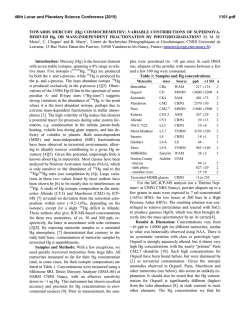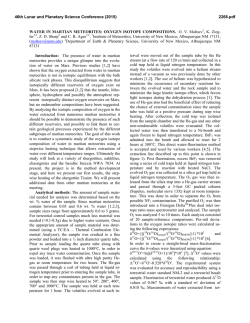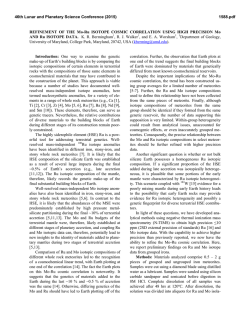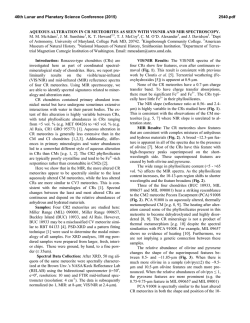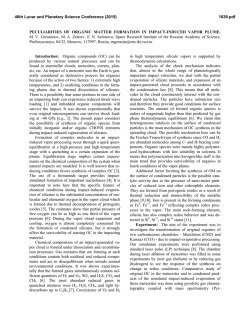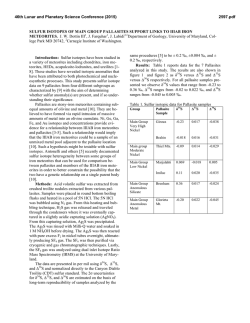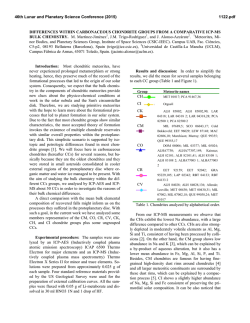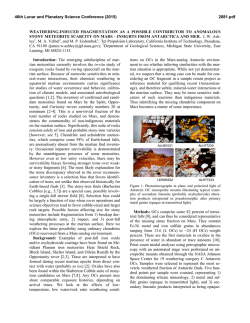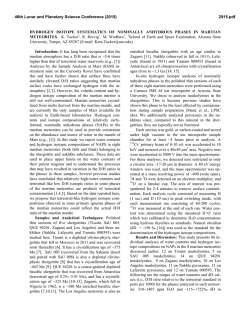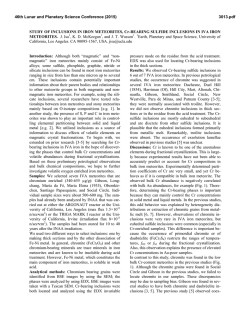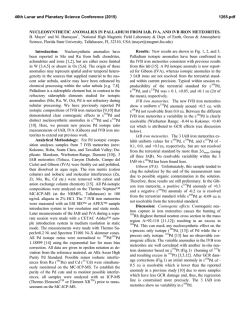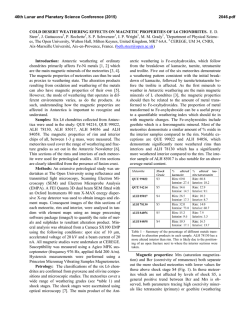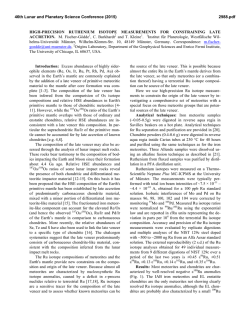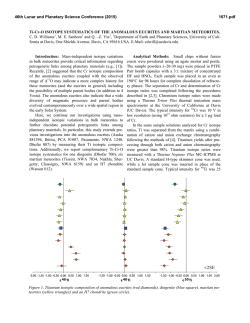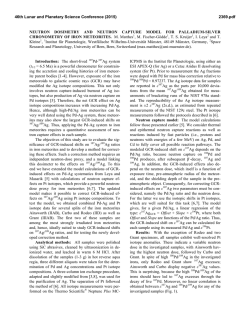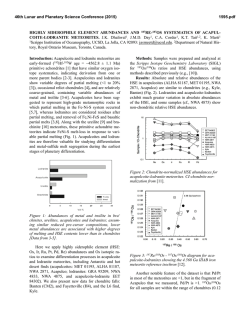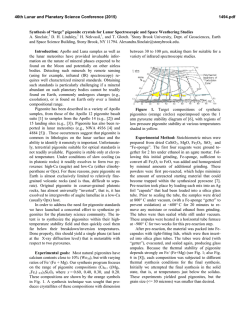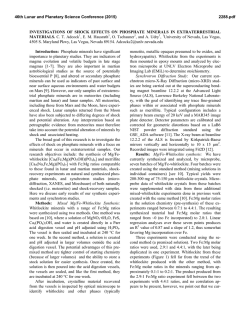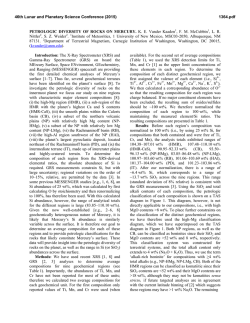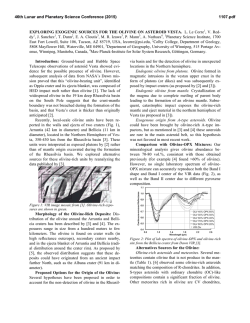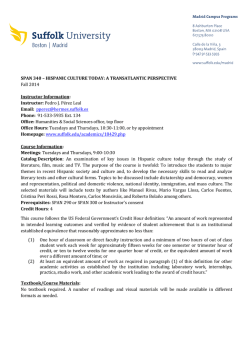
classification of meteorites based purely on bulk elemental
46th Lunar and Planetary Science Conference (2015) 1802.pdf CLASSIFICATION OF METEORITES BASED PURELY ON BULK ELEMENTAL COMPOSITIONS FOR ANALYSIS OF DATA OBTAINED THROUGH SPACE MISSIONS. H. Miyamoto1,2, T. Niihara1, T. Kuritani2, P.K. Hong1, J.M. Dohm1, and S. Sugita3, 1Univ Tokyo (7-3-1 Hongo, Bunkyo-ku, Tokyo 113-0033, Japan; [email protected]) for first author, 2Planetary Science Institute, 3Hokkaido University. Introduction: Critically important for operating the spacecraft during space missions to small bodies, with both engineering-safety and science-return considerations, is the rapid idenfication and classification of the surface materials. Exemplified in the case of the Hayabusa mission, appropriate information was necessarily obtained as the spacecraft approached the relatively small body in order to optimize the landing, as well as in situ sampling for eventual return to the Earth [1,2]. Consistent with the Hayabusa mission, there will be future missions to small bodies such as the Hayabusa 2 and OSIRIS-REx that will employ pre-landingreconnaissance to select both safe and high scienceyielding landing sites for returning materials to Earth. With this in mind, we are working towards developing a method to optimally characterize the materials of a small body. Modern spacecraft carry cameras/spectrometers in the visible to infrared wavelengths, which are powerful tools in identifying surface materials. However, irradiation by cosmic and solar wind irons as well as bombardment by interplanetary dust particles modify the surface of airless bodies through processes known as space weathering. Impact events also mix mateirals at the surface of the body. These processes may flatten or change the absorption characteristics of reflectance spectra. In this sense, elemental compositions, which can be obtained by X and gamma-ray spectrometers, may be useful for the above purpose. Motivations of this study are to understand: (1) how well meteorite classes can be identified through elemental compositions, (2) what combinations of elements may be useful for classification, and (3) what is the least number of elements for the classification. NIPR database of meteorites: To achieve the above, we have developd a new reconnaissance strategy through performing principal component and cluster analysis on bulk elemental compositions of meteorites. Useful databases of bulk meteorite elemental compositions have been reported [3, 4, 5, 6]. In this work we use the NIPR database of meteorite bulk major and minor element compositions [7] for the following reasons: (1) the database includes a total of 520 meteorites covering diverse types; (2) all data are obtained and compiled by the same person, where no intra-laboratory biases are included in the database; (3) the bulk major elemental compositions of the database have been obtained using standard wet chemistry method, so that a higher and consistent precision is expected; (4) samples for the measurements could be randomly selected from the entire collection of the Antarctic meteorites stored in NIPR, and thus, the database considered nearly a random-sampling of the meteorite population found on the surface of the Earth, with the exception of iron meteorites. Caveats of this analysis include: (1) the existence of possible systematic errors involved in the original dataset; (2) alteration by weathering after the fall of a meteorite is not taken into account; and (3) the influence of the heterogeneity of meteorites on bulk elemental composition analysis, which is not fully understood at this stage in our investigation, and there may be sampling biases. At this stage, our statistical analyses using the NIPR Antarctic meteorite database is shown here only to highlight the general utility of the clustering analyses even with possible inclusions of errors discussed above, rather than critically determining exact ranges of elements of each meteorite type. Results and discussion: Bulk major and minor element compositions of 12 elements are used in the statistical analyses: Si, Ti, Al, Fe, Mn, Mg, Ca, Na, K, P, Cr, and Ni (wt. %). We perform hierarchical clustering analyses using Ward’s minimum variance method based on the set of elements. Because of the size of the dendrogram involves 500 samples, a simplified version of the dendrogram was constructed and illustrated in Table 1. It shows that when the meteorites are divided into large two groups, these are a relatively primitive group of meteorites (e.g., chondrites and primitive achondrites such as acapulcoite and lodranite) and a differentiated group of meteorites (e.g., lunar, martian and HED meteorites). Primitive groups are then further classified into: (1) carbonaceous chondrites with primitive achondrites, (2) enstatite and H chondrites, and (3) L and LL chondrites with acapulcoite. Differentiated groups are classified as crustal materials (lunar anorthosite, eucrite, and lunar meteorites (basaltic breccia)) and others (such as diogenite, howardite, and shergottite). Note that these classifications are statistically obtained without any prejudice. We find that cluster analyses using bulk elemental compositions generally agree with conventional classification [8] on the basis of petrographical observations and mineral compositions at the level of class and clan. Surprisingly, the accuracy of the classification is pretty high; 94% of meteorites are successfully classified into groups consistent with classifications shown by [7]. We also find that the accuracy depends on a set of el- 46th Lunar and Planetary Science Conference (2015) ements for the clustering analysis. Based on principal component analysis, we chose Si, Fe, Mg, Ca and Na, where the highest accuracy of statistical groupings compared to ordinary methods is obtained; sometimes, the accuracy is higher than the cases in which the full set of 12 elements is used (Table 1). We interpret this to be the result of lower concentrations and variations among some elements (e.g. Ti and Cr) relative to other elements, as well as smaller dispersions (lower standard deviations) for some of the other elements, such as K and P. In addition, a flat clustering analysis is performed in our investigation using the k-means method, which finds the k cluster centers, while assigning the objects to the nearest cluster center to minimize the squared distances from the cluster. We use the 5 elements selected above, whose compositional data are scaled individually. When the clusters are plotted on three dimensional biplots using principal components 1, 2, and 3 as x, y, and z axes, respectively, the clusters are clearly distinwished (Fig. 1). We find the correlations of principal components 1, 2, and 3 are 60.2, 19.5, and 14.7%, respectively. Principal component analysis shows that a set of elements, such as Si, Fe, Mg, Ca, and Na, can result in clusters with generally good agreement with those determined through traditional classifications. We consider that the selection of these elements is supported by our standard knowledge of the petrology and chemistry of meteorites. Through comparative analysis among our results and other databases or meteorite data not listed in the NIPR database, we find that an intra-laboratory bias can be an issue as pointed out by [4], and thus realize that the exact values of the ranges of elements of each cluster may need to be modified. Nevertheless, when these values are applied to the Jarosewich’s database of bulk elemental compositions [3], we find that about 80% of meteorites are still properly classified. Futher- Fig. 1. 3-D plot of all of elemental composition data of 500 NIPR meteorites. X, Y, and Z axes are PC1, PC2, and PC3. Points represent each meteorite with color representing each cluster. 1802.pdf more, when the hierarchical clustering analyses by Ward’s minimum variance method and a flat clustering analysis using the k-means method are employed, as discussed above, we find that, again, meteorites can be classified into as many as 8 to 12 groups with the accuracy ranging from 94 to 84%, respectively, using the same set of elements: Fe, Si, Ca, Mg, and Na. This indicates that, though the exact range of each element may be modified, expeditious yet accurate classification of meteorites is possible through a new method based only on their elemental compositions, and thus having great potential to classify the surface materials of a small body during approach and while in situ into a known group of meteorites. Conclusions: Our new method of applying statistical classification using bulk major element composition can approximately reproduce those yielded through current classification schemes based on petrology, mineralogy, and mineral chemistry on the level of “Class to Clan”, though much more expeditiously. We suggest Fe, Si, Mg, Ca, and Na as the especially useful set of elements, because by using abundances of these elements meteorites of the NIPR database can be successfully classified with more than 94% accuracy. Principal components analysis indicates that elemental compositions of meteorites form 8 clusters in the 3 dimensional space of the components, which are interpreted as (1) degree of differentiations, (2) degree of thermal effects, and (3) degree of chemical fractionation. Though the exact ranges of elements of each cluster suffer from the systematic intra-laboratory error, realized through comparing our results with those of another elemental composition database, our new method shows promise in the classification of the surface materials of a small body into a known group of meteorites, having a significant bearing in future reconnaissance. References: [1] Fujiwara, A. et al (2006) Science 312, 1330. [2] Yano, H et al (2006) Science 312, 1350; [3] Jarosewich, E (1990) Meteoritics 25, 323. [4] Nittler, L. et al (2004) AMR 233. [5] Schafer, L. and B. Fegley (2010) Icarus 205, 483. [6] Urey, H.C. and Craig, H. (1953) GCA 4, 36. [7] Yanai, K. and H.Kojima (1995) Catalog of Antarctic Meteorites, NIPR. [8] Weisberg, M.K. et al (2006) Meteorites and the early solar system II, U of Arizona press Table: Simplified version of the dendrogram obtained from the hierarchial clustering analysis
© Copyright 2025
